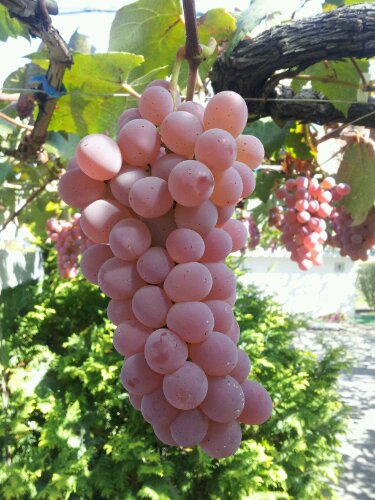Representative Native Varieties of Japanese Wine
Below is a detailed summary of two major native Japanese wine grape varieties, "Koshu" and "Muscat Bailey A."
1.Native Varieties of Japanese Wine
The most notable native grape varieties for Japanese wine are "Koshu" and "Muscat Bailey A." These are unique to Japan and highly regarded both domestically and internationally. Each variety has developed its distinct characteristics and appeal, adapting to Japan's climate and environment. This section covers the history, features, and wine expression of these two native varieties.
2.Koshu: The Iconic Japanese White Wine Grape

Koshu is Japan's native white wine grape variety and is synonymous with Japanese wine. Thought to have been cultivated for over 800 years, it is characterized by long clusters with pale purple-gray grapes. "Koshu" is believed to have traveled to Japan from Central Asia via the Silk Road, evolving to suit Japan's environment. Recent DNA analysis has shown that over 70% of Koshu’s genetics are of the European vinifera variety, strengthening its position as a Japanese native variety. In 2010, Koshu became the first Japanese variety registered by the International Organisation of Vine and Wine (OIV), enhancing its international reputation, particularly in European markets.
Koshu wines are characterized by their delicate flavor, with fruity aromas reminiscent of citrus and peach. They have a refreshing and light palate, with moderate acidity and a hint of bitterness, pairing exceptionally well with Japanese cuisine. Koshu wine complements traditional Japanese dishes like sushi, tempura, and sashimi, offering a harmonious taste experience. Japanese wineries are exploring diverse winemaking techniques to express Koshu in various styles, including orange wine and barrel-aged wine, creating a wide range of Koshu wines in recent years.
3.Koshu Wine Styles
Since Koshu has thicker skins than other white grape varieties, several winemaking styles focus on extracting flavors from the skins. The main styles are as follows:
- Koshu-Maceration Style (Orange Wine)
Koshu has a traditional "maceration" technique where grape skins and seeds are soaked with the juice during fermentation. This practice has long been used in Katsunuma. The technique produces an amber-colored wine, also known as orange wine, which has a rich depth and firm texture that pairs well with rich or strongly flavored foods. - Stainless Steel Tank Fermentation
To maximize Koshu's refreshing citrus aroma and fresh taste, it is commonly fermented in stainless steel tanks. This method preserves Koshu's pure fragrance and acidity, creating a wine that pairs well with lighter Japanese dishes like sashimi. This style emphasizes Koshu's clean and refreshing taste. - Barrel Aging
Barrel-aged Koshu wines acquire complexity and depth. The addition of barrel aromas brings richness and complexity to the fruity character of Koshu. The degree of aging and type of barrel produce diverse expressions, making barrel-aged Koshu a good match for rich or Western dishes. - Blended Wines
Koshu’s delicate flavor profile also makes it suitable for blending with other grape varieties. Blending with more aromatic varieties can enhance Koshu's soft flavors and create new tastes. Each winery’s unique approach to blending helps expand Koshu's potential.
4.Muscat Bailey A: Japan's Leading Red Wine Grape

The other notable native variety is "Muscat Bailey A." This black grape was developed by Zenbei Kawakami, known as the "Father of Japanese Wine," in Niigata Prefecture in 1927. It was created by cross-breeding Bailey and Muscat Hamburg varieties. With excellent disease and moisture resistance, it is well-suited to Japan's climate, making it widely cultivated in major production regions like Yamanashi, Yamagata, and Nagano Prefectures.
Muscat Bailey A is characterized by sweet, candy-like aromas and strawberry-like fruitiness, producing light and soft wines. With low tannins, it is appreciated as an easy-to-drink, fruity red wine and is also used in various styles, such as aged, rosé, and sparkling wines, offering versatility. In 2013, it was registered by OIV as the second internationally recognized Japanese variety after Koshu.
5.Muscat Bailey A Wine Styles
Muscat Bailey A is also expressed through a range of winemaking styles, enriching Japan's unique red wine culture. The main styles include:
- Fruity and Light Red Wine
The typical Muscat Bailey A wine has a sweet, candy-like aroma of strawberry and a light, smooth taste. Its mild acidity and tannins make it an easy-drinking, fruity wine that pairs well with light dishes and Japanese cuisine, popular as an introductory red wine. - Barrel Aging
Barrel aging produces a Muscat Bailey A wine with greater depth. The harmony between barrel and fruit flavors creates a complex and layered wine, suitable for pairing with meat dishes. This style appeals to those seeking a rich, aged red wine. - Rosé Wine
Rosé made from Muscat Bailey A has a light, refreshing taste, achieved by briefly soaking the grape skins. This style, with its fruity aroma and beautiful color, is ideal for summer, often enjoyed chilled, and pairs well with various dishes. - Sparkling Wine
Muscat Bailey A is also excellent as a sparkling wine. Its lively aroma and light taste are well-suited to sparkling, making it ideal for celebratory occasions. - Blended Wine
Muscat Bailey A brings out its unique characteristics when blended with other varieties. Its fruity aroma and mild tannins contribute to a more complex flavor profile in blends, offering a wide variety of tastes.
Koshu and Muscat Bailey A are iconic native varieties that represent Japanese wine. Koshu’s citrus aroma and delicate taste complement Japanese cuisine, while Muscat Bailey A provides an easy-drinking, fruity red wine. These native varieties are rooted in Japan's environment and contribute to the growing international recognition of Japanese wine. As Japanese wine culture continues to develop, these varieties will remain



